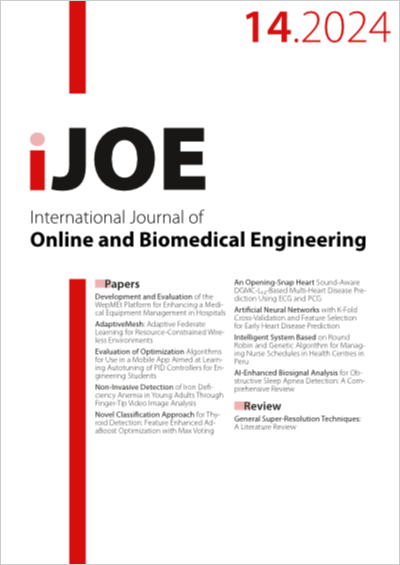Novel Classification Approach for Thyroid Detection: Feature Enhanced AdaBoost Optimization with Max Voting
DOI:
https://doi.org/10.3991/ijoe.v20i14.50623Keywords:
Ensemble Model, Naive Bayes, Thyroid disease predictionAbstract
The need for enhanced methods in disease prediction is a significant challenge in the medical field. Current predictive models often face challenges such as limited accuracy, insufficient adaptability to diverse datasets, and inefficiencies in feature selection and model training. These limitations can hinder early diagnosis and effective management of thyroid conditions, which are vital for patient outcomes. The study introduces an innovative method for enhancing thyroid disease prediction using a machine learning study employs algorithms such as support vector machine (SVM), Naive Bayes (NB), K-nearest neighbor (KNN), logistic regression (LR), and stochastic gradient descent (SGD) in conjunction with filter, wrapper, and embedded feature selection methods across three distinct models. The study uses two thyroid datasets, one from Dew Medicare Ternity Hospital, Nagpur, and the other from the UCI thyroid repository, revealing the potential of the novel ‘FeatureBoostThyro’ approach for improving thyroid risk prediction across diverse datasets. The proposed method achieved accuracies of 98.10%, 97.47%, and 95.58% for the three models using the UCI dataset, and 97.42%, 98.71%, and 97.83% for the DMTH dataset. The novelty of this approach lies in its integrated pipeline that ensures the selection of the best features, systematic model training, and rigorous evaluation. This results in a robust, accurate, and reliable model that outperforms traditional approaches, making it a significant advancement in the field of disease prediction. The enhanced performance metrics, especially accuracy, highlight the potential of this method in clinical settings for early and accurate thyroid disease detection.
Downloads
Published
How to Cite
Issue
Section
License
Copyright (c) 2024 Deepali Bhende, Gopal Sakarkar, Ambika Jaiswal, Punam V. Khandar, Satyajit S Uparkar, Lalit Agrawal

This work is licensed under a Creative Commons Attribution 4.0 International License.



